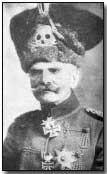Primary Documents - August von Mackensen on the Opening of the Battle of Gorlice-Tarnow, 2 May 1915
 Reproduced below is
August
von Mackensen's summary of the successful opening - for the
German Army - of the Battle of Gorlice-Tarnow, which began on 2 May 1915.
Mackensen's success in command of the Gorlice-Tarnow Offensive led to his
promotion to Field Marshal by
Kaiser Wilhelm II in June
1915.
Reproduced below is
August
von Mackensen's summary of the successful opening - for the
German Army - of the Battle of Gorlice-Tarnow, which began on 2 May 1915.
Mackensen's success in command of the Gorlice-Tarnow Offensive led to his
promotion to Field Marshal by
Kaiser Wilhelm II in June
1915.
Click here to read the German press statement issued relating to the opening of the offensive. Click here to read the reaction of Austro-Hungarian Minister of War Alexander von Krobatin. Click here to read the view of Russian Army Commander-in-Chief Grand Duke Nikolai. Click here to read the view of the British military observer assigned to the Russian Army, Stanley Washburn.
An Account of the Opening of the Battle of Gorlice-Tarnow, 2 May 1915 by General August von Mackensen
To the complete surprise of the enemy, large movements of troops into West Galicia had been completed by the end of April.
These troops, subject to the orders of General von Mackensen, had been assigned the task in conjunction with the neighbouring armies of our Austrian ally of breaking through the Russian front between the crest of the Carpathians and the middle Dunajec.
It was a new problem and no easy undertaking. The heavens granted our troops wonderful sunshine and dry roads. Thus flyers and artillery could come into full activity and the difficulties of the terrain, which here has the character of the approaches of the German Alps, or the Horsal hills in Thuringia, could be overcome.
At several points ammunition had to be transported amid the greatest hardships on pack animals and the marching columns and batteries had to be moved forward over corduroy roads.
All the accumulation of information and preparations necessary for breaking through the enemy's line had been quietly and secretly accomplished. On the first of May in the afternoon the artillery began its fire on the Russian positions. These in some five months had been perfected according to all the rules of the art of fortification.
In stories they lay one over the other along the steep heights, whose slopes had been furnished with obstacles. At some points of special importance to the Russians they consisted of as many as seven rows of trenches, one behind the other. The works were very skilfully placed, and were adopted to flank one another.
The infantry of the allied [Note: Teutonic] troops in the nights preceding the attack had pushed forward closer to the enemy and had assumed positions in readiness for the forward rush. In the night from May 1st to 2nd the artillery fired in slow rhythm at the enemy's positions. Pauses in the fire served the pioneers for cutting the wire entanglements.
On the 2nd of May at 6 a.m. an overwhelming artillery fire, including field guns and running up to the heaviest calibres was begun on the front many miles in extent selected for the effort to break through. This was maintained unbroken for four hours.
At 10 o'clock in the morning these hundreds of fire-spouting tubes suddenly ceased and the same moment the swarming lines and attacking columns of the assailants threw themselves upon the hostile positions.
The enemy had been so shaken by the heavy artillery fire that his resistance at many points was very slight. In headlong flight he left his defences, when the infantry of the [Teutonic] allies appeared before his trenches, throwing away rifles and cooking utensils and leaving immense quantities of infantry ammunition and dead.
At one point the Russians themselves cut the wire entanglements to surrender themselves to the Germans. Frequently the enemy made no further resistance in his second and third positions. On the other hand, at certain other points of the front he defended himself stubbornly, making an embittered fight and holding the neighbourhood.
With the Austrian troops, the Bavarian regiments attacked Mount Zameczyka, lying 250 metres above their positions, a veritable fortress. A Bavarian infantry regiment here won incomparable laurels.
To the left of the Bavarians Silesian regiments stormed the heights of Sekowa and Sakol. Young regiments tore from the enemy the desperately defended cemetery height of Gorlice and the persistently held railway embankment at Kennenitza.
Among the Austrian troops Galician battalions had stormed the steep heights of the Pustki Hill, Hungarian troops having taken in fierce fighting the Wiatrowka heights. Prussian guard regiments threw the enemy out of his elevated positions east of Biala and at Staszkowka stormed seven successive Russian lines which were stubbornly held.
Either kindled by the Russians or hit by a shell, a naphtha well behind Gorlice burst into flames. Higher than the houses the flames struck up into the sky and pillars of smoke rose to hundreds of yards.
On the evening of the 2nd of May, when the warm Spring sun had begun to yield to the coolness of night the first main position in its whole depth and extent, a distance of some sixteen kilometres, had been broken through and a gain of ground of some four kilometres had been attained.
At least 20,000 prisoners dozens of cannon and fifty machine guns remained in the hands of the allied troops that in the battle had competed with one another for the paten of victory. In addition, an amount of booty to be readily estimated, in the shape of war materials of all sorts, including great masses of rifles and ammunition, had been secured.
Source: Source Records of the Great War, Vol. III, ed. Charles F. Horne, National Alumni 1923
The Austro-Hungarian declaration of war was the first ever delivered by telegram.
- Did you know?
